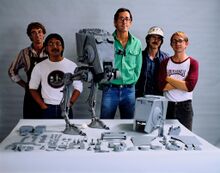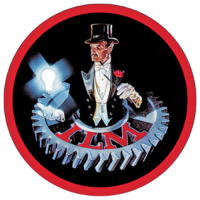Industrial Light & Magic
Industrial Light & Magic (ILM) is the visual effects company responsible for much of the visual effects in the Star Wars films. It was founded by George Lucas in 1975, as part of Lucasfilm Limited. ILM has also created the effects for over 300 other films, including the Jurassic Park series, the Back to the Future trilogy, the Harry Potter films, the Indiana Jones franchise, the Star Trek films, the Pirates of the Caribbean film series, many films in the Marvel Cinematic Universe, the animated film Rango, the 2011 film Super 8, and the 2018 film Ready Player One.
Creation

After George Lucas made the hit movie American Graffiti, he worked on a space opera he called The Star Wars, which was then purchased by 20th Century Fox. Lucas intended to create special effects that had never been done before. However, Fox's in-house special effects department had been shut down because of costs and the publics interest in more realistic looking films. Lucas then decided to create his own effects company. His first choice was Douglas Trumbull, responsible for the photographical effects in 2001: A Space Odyssey. As Trumbull was doing Steven Spielberg's Close Encounters of the Third Kind, he instead recommended Lucas his assistant, John Dykstra. Dykstra then assembled a crew of 75 college students, artists and engineers.
Gary Kurtz bough to crew to work on a warehouse in Van Nuys, California. Looking for a name that would disguise the warehouse's function and suggest it was simply in the business of wholesaling electronic components rather than making movies, Lucas came up with Industrial Light and Magic. In July of 1975, the company was born.
Star Wars work

ILM's first film was Star Wars (called The Star Wars at first). Many at the recently founded company (then jokingly nicknamed "The Country Club") were not sure the new groundbreaking special effects would ever work. The working environment was chaotic and unorthodox: when Fox executives visited the crew to see their progress, one of the employees was wearing a fish-head mask, the artists used an improvised slide to plunge into a swimming pool built in a container, and Dykstra threw a refrigerator from the warehouse's roof "because we wanted to know how it would sound." The artists spent their days smoking marijuana and trying to find relief from the hot environment in bathtubs. Most of the $1 million Lucas lent to the company was spent on equipment, such as miniatures and the Dykstraflex motion control camera — a technology later crucial for scenes such as the Battle of Yavin.
When Lucas returned to California after ending principal photography, ILM was in worse shape than ever before. Except for the escape pod being released from Tantive IV, Lucas found all the completed effects to be unsalvageable. Adding this to the troublesome shooting, most doubted Star Wars would ever reach theaters, and Fox nearly terminated production. Lucas decided to take direct control of the company, supervising the effects work daily. The battle scenes were mostly directly copied from dogfights taken from World War II movies such as Tora! Tora! Tora! which Lucas used as reference.
Lucas also brought in some third parties to complete effects, such as Dan O'Bannon, Rick Baker and Phil Tippett.
Once the film was completed, most of the crew at ILM decided to stay, but Dykstra brought some of the artists to form his own company, called Apogee.
Although ILM primarily worked on Star Wars projects, they also had a hand in some Star Trek projects, including Star Trek II: Wrath of Khan. Mark Hamill, upon discovering this during production of Return of the Jedi, jokingly referred to them as traitors, with Lucas stating that it was a business.[2]

In 2010, ILM allowed the show The Amazing Race to film at their complex. They set up a challenge for the contestants on the show, which involved the characters of Ponds, Cody, and Padmé Amidala from The Clone Wars.
ILM TV, launched in 2018, is a branch of ILM that focuses on episodic and streaming television. It collaborates with the ILM Experience Lab, and worked on the live action Star Wars series The Mandalorian. Aside from The Mandalorian, it will also help create the second season of Krypton on SyFy. Their headquarters is located at ILM's London studio.[3]
Notable artists
- John Dykstra founded ILM, leading a team that included Richard Edlund, Dennis Muren, and future director Joe Johnston.
- Edwin Catmull's Pixar was at first the computer graphics department of ILM.
- The famous digital artist Juan-Luis Sanchez worked for ILM between 2001 and 2006, during this time working on both Star Wars: Episode II Attack of the Clones and Star Wars: Episode III Revenge of the Sith.
- Jai Natarajan was the technical director who worked on The Phantom Menace.
- Steve Williams was also an animator for ILM.
- Masi Oka worked at ILM before becoming an actor.
- Chris Voy, art director for Star Wars: Episode IX The Rise of Skywalker.
- Stephen Zavala, senior concept artist for Star Wars: Episode IX The Rise of Skywalker.
Sources
Notes and references
- ↑
 Visual Effects on Lucasfilm.com (backup link)
Visual Effects on Lucasfilm.com (backup link)
- ↑ The Making of Return of the Jedi
- ↑ Bishop, Bryan: Industrial Light & Magic opens TV division just in time for Disney's new Star Wars show (2018-11-07). The Verge (archived from the original on April 23, 2020)
